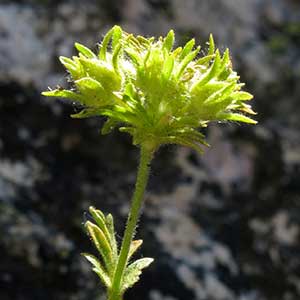Ivesia longibracteata
Ivesia paniculata
Castle Crags ivesia, longbract mousetail
Ash Creek ivesia, Ash Creek mousetail
ascending to erect, 0.3–1.2 dm.
± prostrate, 0.4–1.5(–2) dm.
weakly planar to loosely ± cylindric, (0.5–)2–4(–6) cm; sheathing base glandular abaxially, otherwise glabrous;
petiole 0.5–2 cm, hairs 0.2–1 mm;
leaflets 5–6 per side, 2–6 mm, ± short-hirsute, glandular-puberulent, lobes 2–7, oblanceolate to spatulate or obovate, apex not setose.
tightly cylindric, (1.5–)2–5(–7) cm; sheathing base densely hairy abaxially;
petiole 0.5–4 cm;
lateral leaflets (5–)8–15 per side, overlapping at least distally, ± flabellate, 0.5–2 mm, incised to base or nearly so into (0–)3–8(–15) elliptic to narrowly obovate lobes, apex not or obscurely setose, surfaces densely hirsute, cryptically glandular;
terminal leaflets indistinct.
1–3, not paired.
(0–)1;
blade reduced.
3–14-flowered, 1–2.5 cm diam.;
glomerules 1.
20–200-flowered, congested, (1–)1.5–6(–10) cm diam.
1.5–6 mm.
1.5–6 mm.
8–10 mm diam.;
epicalyx bractlets linear to narrowly lanceolate or elliptic, 2.5–5 mm, longer than sepals;
hypanthium shallowly cupulate, 0.5–1 × 2–3 mm;
sepals 1.5–2.5 mm, ± acute;
petals pale yellow, linear to narrowly oblanceolate, 1.5–2.5 mm;
stamens 5, filaments 0.7–1.3 mm, anthers yellow, 0.5–0.8 mm;
carpels 6–11, styles 1–1.5 mm.
4–6 mm diam.;
epicalyx bractlets 5, lanceolate to elliptic, 0.6–1.5(–2) mm;
hypanthium shallowly cupulate, 1 × 2–3 mm;
sepals (1–)1.5–2.5(–3) mm, acute;
petals white to pale yellowish, linear, 1 mm;
stamens 5, filaments 0.3–1 mm, anthers yellow with maroon margins, ovate, 0.3–0.5 mm;
carpels 1–2(–3), styles 0.7–1.8 mm.
cream to light tan, 1.2–1.5 mm.
brown, 0.8–1.5 mm, smooth, prominently carunculate.
Ivesia longibracteata
Ivesia paniculata
Of conservation concern.
Ivesia longibracteata is known only from the Castle Crags area of Shasta County. The epithet alludes to a diagnostic characteristic unique in the genus: the epicalyx bractlets are longer than the sepals. The plants grow on vertical rock faces, a habitat more characteristic of sect. Setosae; however, the stems are ascending to erect and do not form hanging clumps, and the pedicels are not curved in fruit.
(Discussion copyrighted by Flora of North America; reprinted with permission.)
Of conservation concern.
Ivesia paniculata is known only from the Ash Valley area of Lassen County. The distinctions between I. paniculata and I. rhypara are perhaps on the same scale as variation among disjunct population clusters of I. rhypara, but no taxonomic adjustments are proposed at this time.
(Discussion copyrighted by Flora of North America; reprinted with permission.)


